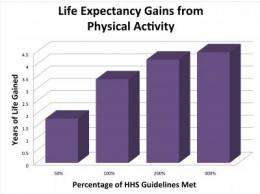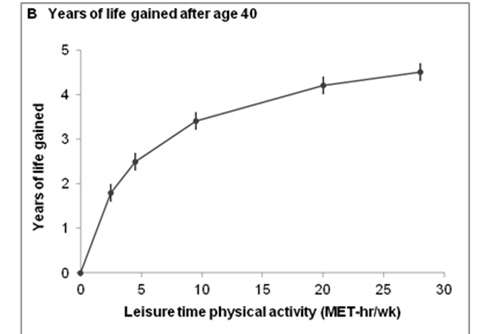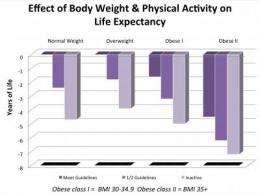Researchers quantify how many years of life are gained by being physically active

In a new study from Brigham and Women's Hospital, in collaboration with the National Cancer Institute, researchers have quantified how many years of life are gained by being physically active at different levels, among all individuals as well as among various groups with different body mass index.
We all know that exercise is good for you, but how good? While previous studies have shown the link between physical activity and a lower risk of premature mortality, the number of years of life expectancy gained among persons with different activity levels has been unclear—until now. In a new study from Brigham and Women's Hospital (BWH), in collaboration with the National Cancer Institute, researchers have quantified how many years of life are gained by being physically active at different levels, among all individuals as well as among various groups with different body mass index (BMI).
The study will be published on November 6, 2012 in PLOS Medicine.

"We found that adding low amounts of physical activity to one's daily routine, such as 75 minutes of brisk walking per week, was associated with increased longevity: a gain of 1.8 years of life expectancy after age 40, compared with doing no such activity," explained I-Min Lee, MD, associate epidemiologist in the Department of Preventive Medicine at BWH and senior author on this study. "Physical activity above this minimal level was associated with additional gains in longevity. For example, walking briskly for at least 450 minutes a week was associated with a gain of 4.5 years. Further, physical activity was associated with greater longevity among persons in all BMI groups: those normal weight, overweight, and obese."
In pooled data from six prospective cohort studies, the researchers examined associations of leisure-time physical activity of a moderate to vigorous intensity with mortality. They analyzed data from more than 650,000 subjects and followed subjects for an average of ten years- analyzing over 82,000 deaths. The large sample size allowed them to estimate years of life gained after the age of 40 among persons with different levels of physical activity and BMI.

The findings show that physical activity was associated with longer life expectancies across a range of activity levels and BMI groups. Participation in a low level of leisure time physical activity of moderate to vigorous intensity, comparable to up to 75 min of brisk walking per week, was associated with a 19 percent reduced risk of mortality compared to no such activity.
Assuming a causal relationship, which is not specifically demonstrated in this research, this level of activity would confer a 1.8 year gain in life expectancy after age 40, compared with no activity. For those who did the equivalent to 150 min of brisk walking per week—the basic amount of physical activity currently recommended by the federal government—the gain in life expectancy was 3.4 years. These benefits were seen in both men and women, and among white and black participants. Importantly, they were also observed among persons who were normal weight, overweight, and obese. Participants faring best were those who were both normal weight and active: among normal weight persons who were active at the level recommended by the federal government, researchers observed a gain in life expectancy of 7.2 years, compared to those with a BMI of 35 or more who did no leisure time physical activity (a 5 ft 5 in tall person with BMI of 35 weighs 210 lb).
"Our findings reinforce prevailing public health messages promoting both a physically active lifestyle and a normal body weight," explained Dr. Steven C. Moore, PhD, research fellow at the National Cancer Institute (NCI) and lead author of this study. This findings may also help convince currently inactive persons that even being modestly active is ''worth it'' for greater longevity, even if it may not result in weight control.
More information: Moore SC, et al. Leisure Time Physical Activity of Moderate to Vigorous Intensity and Mortality: A Large Pooled Cohort Analysis. PLoS Medicine. November 6, 2012. doi: 10.1371/journal.pmed.1001335

















